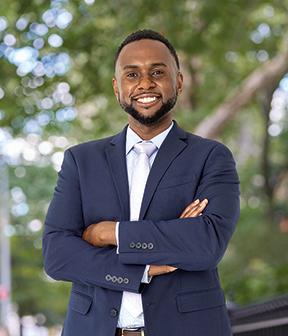In 2021, while Professor of Clinical Law Daniel Harawa was teaching an appellate clinic at Washington University in St. Louis School of Law, one of his students raised a question about the appeal they were preparing in a search-and-seizure case. “Why aren’t we talking about the fact that our client is Black?” the student asked.
The easy answer was that raising the issue of race in this way isn’t often done in criminal procedure cases. But, Harawa says, he resisted the impulse to give that quick response. Instead, he decided to examine why race is often not discussed in the defense of clients who had been apprehended and searched by the police.
The results of his inquiry were two papers: “Whitewashing the Fourth Amendment,” published in 2023 in the Georgetown Law Journal, which examines how lawyers fail to discuss race when advocating for their clients, and a new paper, “Coloring in the Fourth Amendment,” forthcoming in the Harvard Law Review. In his new work, Harawa examines the justifications that courts have used for excluding race in Fourth Amendment seizure cases. In particular, Harawa explores the theory of constitutional colorblindness, which holds that race must not be a consideration in resolving constitutional questions.
One of Harawa’s goals with the paper, he says, is to combat what he calls “case law creep”: the misapplication of case law and legal theories created in one context to promote ideological aims in a different context. In this instance, he focuses on how colorblind constitutionalism—created in response to equal protection cases under the Fourteenth Amendment—is often incorrectly mapped, in his view, onto criminal procedure cases under the Fourth Amendment.
The Fourth Amendment guarantees the right to be free from unreasonable seizures by the government. In determining whether a person has been unconstitutionally seized by police officers, courts consider whether a “reasonable” person would feel free to terminate the police encounter. Courts will analyze how many police officers were present, the tone and content of the exchange between the police and the individual, and whether the police displayed any show of force. However, the courts often, Harawa says, fail to consider that person’s race.
Excluding race from the reasonable person analysis “can leave the impression that race has no influence on policing in America,” writes Harawa. “A notion belied both by empirics and public sentiment, and perhaps more importantly, one that is at odds with how the people from many communities experience policing.” In addition, Harawa notes the ways that the courts have allowed race to be explicitly and implicitly used by law enforcement, including when police build criminal profiles.
While the Supreme Court has not explicitly ruled about the use of race in Fourth Amendment seizure cases, a few decisions at the federal appellate level have adopted the rhetoric of constitutional colorblindness, says Harawa. He points to the US Court of Appeals for the Tenth Circuit’s decision in US v. Easley and the US Court of Appeals for the Eleventh Circuit’s decision in US v. Knights: in both cases, the courts rejected the use of race in evaluating Fourth Amendment seizure cases. Combing through the decisions, Harawa isolates three reasons the courts gave for the exclusion: that using race will rely on stereotypes, that it would be impossible to administrate an objective test for how race impacts interactions with police, and that using race would lead to discrimination.
But these justifications, Harawa says, are built around concepts created in Fourteenth Amendment cases, where adherents to constitutional colorblindness operate on the belief in a zero-sum game: in a limited pool of resources, one race should not benefit at the expense of another. As an example of this argument in action, Harawa points to 2023’s Students for Fair Admissions (SFFA) v. Harvard, which curbed race-conscious college admissions.
In Fourth Amendment cases, however, this reasoning does not hold up, Harawa writes. In fact, he says, a more logical application of the theory of constitutional colorblindness would demand a discussion of race.
“As we saw in SFFA, the majority believed that a consideration of race in college admissions diminished people’s individuality: it reduced people to stereotypes about their race on the one hand and discriminated against others on these terms on the other,” says Harawa. “But in Fourth Amendment cases, a concern about individuality would require a discussion of race, so that an individual, with all their textured experience, could fully explain all the dynamic elements of their case.”
Far from being a zero-sum game, Fourth Amendment cases revolve around the definition of a reasonable person and the considerations that a reasonable person would make during a law enforcement search. For a person to be able to fully explain their reasoning, it’s often necessary to discuss how their race played a part, Harawa says. At the core of whether the reasonable person analysis can consider the impact of race in police searches and seizures is a question about dignity, he says, asking: “Who is the law willing to recognize?” He argues that the concept of a race-neutral reasonable person is, in fact, a racialized concept, but one that is built on the experiences of White people.
Following the 2020 murder of George Floyd by Minnesota police officers and widespread calls for reform to racist policing practices, Harawa says some lower courts have begun to consider how a person’s race may factor into their belief in their ability to claim their Fourth Amendment rights. Harawa says that it is important to maintain this momentum without regard to what the Supreme Court might do if it were to ever address the question of whether race can be considered in Fourth Amendment seizure cases.
Harawa disputes that constitutional colorblindness is meant to strive towards equality in the first place. He emphasizes the importance of laying a groundwork for more progressive legal doctrine by first detailing the problems and incongruities in the prevailing thought.
“As someone who not only writes, but teaches in a clinic, I have to hope that the law progresses forward,” he says. “I have to articulate a progressive vision of how the law could be. I think there’s a lot of great scholarship that helpfully criticizes the courts, but there’s a dearth of scholarship that provides a progressive path forward in light of the courts as they stand. And I hope my article does that.”
Posted March 25, 2024. Photos: Adobe Stock/Nemanja (rear-view mirror); JJ Lane (Harawa)

